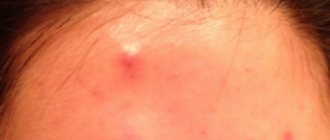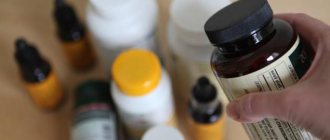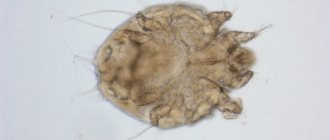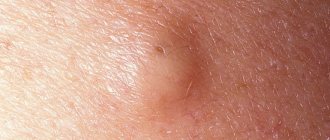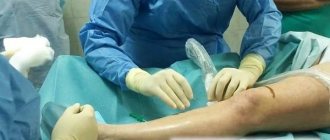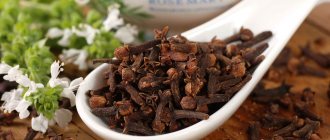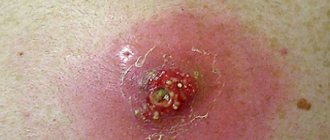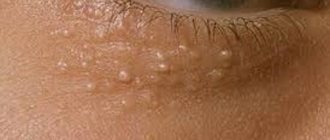Wounds
Improper treatment of purulent wounds is fraught with the occurrence of areas of necrosis and blood clots. Healing is carried out with the help of medications prescribed by the doctor. It is advisable to treat purulent wounds at home if the damage is not extensive, no more than 5 cm, and only in consultation with a specialist.
Application of ointments
Thanks to antiseptic pulling local preparations, not only the life cycle of the pathological element is shortened, but also purulent tissue damage is minimized. It is recommended to use the following tools:
- Ichthyol ointment. The active component is ichthammol (a derivative of shale resins). The product has analgesic, disinfecting properties, stimulates regeneration, effectively fights itching, and is used in the form of applications. In order for the purulent masses to quickly come out, it is necessary to soak cotton wool in ointment, apply it to the abscess, cover the area with parchment and fix it on the skin with a plaster. The duration of the procedure is 8-10 hours. At the end of the specified period, the manipulations are repeated.
- Balsamic liniment (according to Vishnevsky). It draws out pus well by accelerating the course of the inflammatory process (the abscess matures faster), and heals the resulting wound. Applications, compresses, and lotions are made based on the ointment.
- Levosin. The drug is one of the inexpensive but effective means for eliminating ulcers. Has anti-inflammatory, necrolytic effects. Used in the same way as Ichthyol ointment.
- Syntomycin ointment. The product belongs to the group of local broad-spectrum antibiotics - it is not used on an ongoing basis, but can be used when abscesses appear. To achieve a quick positive result, it is recommended to act according to the instructions.
- Streptocide ointment. Thanks to the active ingredient, sulfanilamide, it effectively fights microbes. If you have kidney problems, the drug should be used with caution.
- Levomekol. The product eliminates purulent tissue inflammation, promotes the release of exudate from boils, and stimulates regeneration due to the presence of methyluracil and the antibiotic chloramphenicol in the immunostimulant.
Compresses for drawing out pus with pharmaceutical ointments are applied according to certain rules:
- Medicines are not applied directly to the skin. They are applied to the problem area using a cotton swab and then fixed (using a bandage or plaster).
- The surface to be treated must be clean and dry.
- If the frequency of replacement is not specified, the compress is renewed after 4-6 hours.
- If the abscess is tightly tied with a bandage, the situation may worsen: you cannot make the bandages tight.
When the purulent exudate comes out, the wound surface is disinfected with hydrogen peroxide, Chlorhexidine, Furacilin or a slightly pink solution of potassium permanganate before treatment with ointment.
Making homemade ointments
Instead of pharmaceutical drugs, homemade products are often used. Ointments allow you to quickly cope with boils:
- With butter and beeswax 4:1. The butter is melted and thin wax shavings are added to it. In order for the wax to melt, a homogeneous mass is obtained, the composition is heated (do not allow it to boil). The ointment is used for warm compresses. Applies for 2 days. Due to dry heat, the abscess will ripen and open faster.
- With turmeric (½ tbsp), honey (1 tbsp), ground ginger (½ tsp). The mixture is salted, applied to gauze, and applied to the surface of the boil. It is recommended to apply cling film on top and secure the compress with gauze or bandage.
- With aloe leaves, spruce resin, tar, butter. The ingredients are taken in equal quantities and melted (the container with the ingredients is placed in a pan of water and heated). The ointment is a homogeneous creamy mixture. How to draw out purulent masses: the product must be applied to the sore spot before bedtime and left until the morning.
- With lamp and olive oils, wax (1:1:1), sugar (pinch). The ingredients are mixed and brought to homogeneity over a fire using a water bath. The resulting mass is transferred to a glass jar to extend shelf life. The pus will come out quickly if application procedures are carried out regularly. The period during which the ointment is kept on the skin is 3-5 hours daily.
- With plantain (crushed leaves, 1 tbsp), vegetable oil (any, 1 tbsp). The ingredients are mixed, the finished composition is applied to the problem area. One procedure lasts 5-6 hours. Sessions are held every day. The treatment course lasts a week. During this time, the mixture draws out pus and eliminates inflammation.
Boils (boils), carbuncles, furunculosis. Folk recipes
Mustard treatment
For furunculosis, take a teaspoon of mustard powder into your mouth, suck for 20 minutes, trying to form it into a lump with your tongue. Swallow your saliva.
Do it for 3 days in a row (this does not depend on food intake). For the next 3 days, do it every other day. As a rule, old abscesses open, new ones no longer appear. This method also helps to get rid of carbuncles.
Ancient recipes for fighting boils
- In the old days, boils were treated with chalk, laundry soap and unsalted pork fat. The components were mixed in equal quantities, laid out on canvas and tied to the sore spot. All suppuration usually disappears within a day.
- Cut an agave leaf so that the juice appears, brush the top with honey, and apply this “plaster” to the boil, secure it, and keep it for several hours. All the pus will come out. And if a wound appears, you need to apply a plantain leaf to it, slightly crushing it, and secure it. In a couple of days everything will be delayed. During treatment, boils should not be wetted and should not be heated, otherwise the inflammatory process will only intensify.
Treatment with blue clay
Add apple cider vinegar to pharmacy blue clay. Stir the mixture until pasty, apply it to the inflamed area, cover with cellophane, cloth, and secure. Keep it overnight. Several procedures are enough for healing.
Nettle based recipe
For furunculosis, heat the bathhouse and pick nettles. Fill it with boiling water in a saucepan, simmer briefly, pour this infusion into a large tub. Add 2 buckets of hot water there.
Compress recipes
Folk remedies that allow a brewing boil to break through faster are not only represented by ointments. There are recipes for stretching compresses that show good results in practice. The question of their use is relevant when the contents of the abscess do not come out for a long time. How to extract pus from a boil is discussed below.
Baked onion
First it must be cleaned and cut into two parts. Suitable for baking are oven (180°C, 5 min), microwave (maximum power, 10 min), frying pan (cut side down, without oil, 10 min). After heat treatment, the onion should be pulled out and cooled to an acceptable temperature, then applied to the diseased area with the cut side and bandaged. The dressing is changed twice or thrice a day.
Potato or carrot tubers
The patient determines how much raw material is required independently. A paste is made from raw vegetables at home with a grater, which is applied to the suppuration and covered with polyethylene (cling film). The compress is fixed with a bandage. The bandage is left for 3 hours and replaced.
Buckwheat
If boils appear, so that the pus does not linger, it is boiled, part of it is wrapped in gauze, and applied to the inflammation. Another recipe uses raw grains, which are roasted and ground to make a dough. Soda and water are added to the flour in small quantities. After kneading, a flat cake is obtained. Compresses are applied 2 times daily.
Cranberry juice
Fresh or frozen berries are suitable for preparation. The cranberries are placed in a container and kneaded, the pulp is filtered. The juice is used as a daily lotion.
Aloe
A compress with plant pulp will be a reliable remedy in the fight against inflammation. To obtain a healing agent, the washed, peeled leaf is crushed to the desired state. The slurry is laid out on the suppuration, covered with a bandage folded several times, and fixed with an adhesive plaster. Aloe produces the best results with regular procedures. It is recommended to renew compresses twice or thrice during the day.
Laundry soap
It is ground into small chips and placed in a container. Then milk is poured in. You can determine how much liquid is needed by eye. Milk is added until the chips are completely covered. The mixture should be boiled over low heat for an hour and a half, stirring. The resulting creamy composition is cooled, applied to gauze, and applied to the abscess. Procedures are carried out at least 2 times daily.
Causes of pus accumulation
Our body has a complex defense mechanism that instantly reacts to outside invasion.
A furuncle or boil begins to form after microbes enter the hair follicle. At this moment the following happens. The immune system reacts in such a way as to quickly get rid of the foreign substance. To begin with, blood flow to the problem area increases. At this point, the content of white blood cells - leukocytes - increases in it. They have a protective function.
In addition to leukocytes, a large number of macrophages accumulate in the area of the boil. These immune cells literally “eat” microorganisms using special enzymes that they consider foreign. In this process they die. This forms an abscess, which consists of a large number of dead macrophages, leukocytes, as well as active pathogenic microbes that have not yet been neutralized.
Depending on the size of the boil, the pus in it takes 2-7 days to mature. During this period, a core must form in the center of the abscess. At a certain point, the pus bursts out, leaving behind an empty cavity. How many days the pus comes out of the boil also depends on its size. The less suppuration, the faster it heals. In some cases, the pus does not want to come out completely, then the use of bandages with special means of medicinal or folk origin is required.
Removing pus and treating the wound
If a pathological element breaks through, the contents must be completely removed. The procedure begins with disinfection of hands and the edges of the wound surface. The leaking contents are carefully wiped off with a clean swab.
It is forbidden to press hard on the abscess or use improvised means or fingernails, since there is a high probability of infection.
If the area remains dense after the procedure, not all of the exudate has been removed. The squeezing stops, an ointment is applied (Ichthyol, Levomekol, Vishnevsky are considered the best), which helps to draw out the remaining purulent masses and stop the inflammatory process.
When the contents of the abscess are removed, the cavity is disinfected and treated with a regeneration-stimulating agent (for example, Levomekol). The wound is isolated with a sterile dry bandage. After 4 hours, it is necessary to make a dressing and repeat at similar intervals until the skin heals. To prevent the seal from appearing again, treatment procedures must be carried out regularly.
Please leave a comment:
Please leave a comment:
A suppuration of a cut, an abscess, a boil - rarely does anyone manage to never encounter such phenomena in their life, the cause of which can even be microtrauma. A common practice is to treat suppuration surgically, and purulent surgery is considered one of the most ancient medical practices. At the same time, folk remedies for abscesses can quickly cure small wounds at home, and they can even save a human life if medical help is unavailable. It should be noted that this applies only to subcutaneous inflammation - the internal purulent process requires urgent surgical intervention.
What is an abscess?
The formation of a subcutaneous abscess occurs as follows:
- Due to a violation of the integrity of the skin, an infection enters the body, primarily staphylococcal.
- A capsule is formed at the site of infection, preventing further infection of the tissue. This manifests itself in the form of hardening, redness, and soreness.
- Exudate formed by dead microorganisms, leukocytes and destroyed tissues accumulates inside the capsule.
- After about a week, the resulting pus breaks through the capsule and comes out. The process of wound scarring and tissue restoration begins.
However, if the suppuration is deep and the wound channel is narrow, the pus can penetrate deep into the tissue. This leads to sepsis, the treatment of which can be long, serious and not always successful.
That is why medicine is often guided by the rule: “if you see pus, open it immediately.” The opening of the capsule is carried out under local or general anesthesia, after which the wound is cleaned and sanitized, drainage is installed to drain the exudate and a sterile dressing is applied, which is changed during regular examination. After the inflammation has stopped, the drainage should be removed and medications to promote skin healing should be used. This treatment is the most radical and successful. However, minor suppuration located near the surface of the skin can be treated at home, especially if obtaining surgical help is difficult.
Pharmaceuticals
It must be remembered that any damage to the skin, except that caused by a sterile instrument, is associated with infection . Therefore, if signs of suppuration and inflammation appear, you need to prevent the wound from closing by constantly moistening it with hydrogen peroxide or simply salt water. In order to cope with the infection and draw out the pus, there are many effective medications. Almost all of them are available in any pharmacy and are affordable. At home, you can treat an abscess with drugs such as:
- Vishnevsky ointment (balsamic liniment).
- Ichthyol ointment.
- Levomekol.
- Streptocide ointment.
- Syntomycin ointment, etc.
Before applying the ointment, you need to treat the surface of the skin with hydrogen peroxide or furatsilin, and after applying the ointment, cover it with a clean bandage . The ointment and bandage should be changed according to the instructions for use of this product.
Causes of boils
Staphylococcal infection is the main cause of the disease. Normally, these microorganisms are always present on the human body without causing harm. This is explained by the low pathogenicity of staphylococcus - only 10% of them are dangerous. But when a person suffers from furunculosis, this ratio changes. In this case, the number of pathogenic staphylococci on the skin can reach 90% of the total number. Such disorders occur after skin infection, after contamination, or as a result of decreased immunity.
Often the body becomes vulnerable as a result of chronic processes or viral infections (tuberculosis, pyelonephritis, bronchitis, hepatitis, sinusitis, tonsillitis). Immunity may decrease as a result of metabolic disorders (diabetes mellitus, endocrine obesity), long-term use of medications that can suppress the body's protective properties.
Staphylococcus penetrates the hair follicle in places of injury, maceration, and scratching. In the area of the nose and ears, boils can form due to the constant influence of mucopurulent discharge on the surface of the skin (with rhinitis, otitis media, adenoiditis, etc.).
Folk remedies
For centuries, most people had to treat suppurations on their own, so among folk remedies there are many whose effectiveness has been proven by time. It is important that many of them (onions, garlic, cabbage, honey, etc.) are common food products, which allows you to treat an abscess without wasting effort and time. The most accessible means of drawing out pus “far from civilization” are:
- warm tea leaves;
- raw onion, cut into slices;
- young birch leaf;
- plantain or burdock leaf;
- sagebrush.
At home you can also apply to the abscess:
- fresh cabbage leaf;
- grated onion, preferably mixed with honey;
- grated carrots, potatoes or beets;
- pulp of an aloe or Kalanchoe leaf;
- mashed cranberries.
The therapeutic application of these products must be changed as it dries; it can be worn constantly. The beneficial substances contained in these plants will help draw out pus, relieve inflammation and speed up the restoration of damaged tissues. To avoid skin burns, apply onion in the morning and evening for no more than two hours, then rinse with water. Baked or boiled onions have a milder effect. Baked garlic also draws out pus well.
Small pimples, treatment with traditional methods
In one of the articles you can find out many more useful recipes for treating acne with folk remedies.
Treatment of pimples on the face
This folk recipe is especially necessary for girls and boys who cannot get rid of pimples on their faces. Prepare a healing lotion from spruce pine needles (you can use the New Year tree after the holiday).
- Grind approximately 120 g of pine needles into a 0.7 liter jar, add 10 g of dried plantain, calendula, and chamomile flowers.
- Pour the mixture with half a liter of vodka, give it a week to infuse.
- Then strain into a dark glass container.
- Store the lotion in the dark (no longer than a year).
- Apply in the evening with a cotton swab (always on clean skin).
Treatment of pimples on the body
Massive pimples on the back indicate slagging in the body. You can cleanse yourself with enemas according to Malakhov or use another method of cleansing the body.
However, masks will help remove pimples.
- Mix 100 g of salt with 2 cups of almonds (ground), pour in milk to form a homogeneous paste.
- Apply this mixture to your back (if necessary, to your shoulders and chest). After 10 minutes (just be careful!), rub into the skin, and after 5 minutes, rinse with warm water.
- At the end of the procedure, wipe the skin with a moisturizing toner that does not contain alcohol.
Conclusion about folk remedies
Rural residents almost always cured boils, abscesses and inflammations with folk remedies, independently, using home and herbal remedies.
Thus, folk recipes against such diseases were constantly improved. Today, their effectiveness is sometimes not inferior to pharmaceutical drugs. And most importantly, folk remedies do not cause side effects.
Chamomile and string will also help you treat acne.
If you find an error, please select a piece of text and press Ctrl+Enter.
Homemade ointment for boils
To prepare a homemade anti-blister ointment, you need to mix raw yolk with honey and butter (a tablespoon each) and add flour to this mixture (even better - cosmetic clay) so that you get a soft dough that needs to be stored in the refrigerator. A cake from this mixture should be applied to the wound and changed three times a day, continuing treatment even after the wound begins to cleanse.
If the internal abscess is located on the finger, especially under the nail, it should be periodically steamed in hot water, to which salt, soda, and alcohol tincture of calendula are added (a teaspoon per glass).
Damage to the skin is a fairly common occurrence. If you receive such an injury, it is recommended to immediately treat the wound with antiseptic drugs: hydrogen peroxide, chlorhexidine, furatsilin. If the infection continues to progress and pus accumulates in the wound, then use pharmaceutical and folk remedies that can draw out the exudate. Both medical and natural medicines quite successfully eliminate abscesses, disinfect and accelerate the healing of skin lesions, so everyone decides for themselves which one is better at drawing out pus and which is more convenient to use.
At the same time, you need to understand that such products are used to eliminate minor external and subcutaneous injuries. For extensive skin abscess, treatment is carried out by a doctor. It is difficult to cope with complex wounds using only external medications. Patients in serious condition require complex therapy, and sometimes surgical treatment.
Homemade propolis ointment
We will make an ointment for abscesses, and a proven remedy for hundreds of diseases - propolis - will help us with this.
Propolis tincture can be bought at a pharmacy, or you can prepare it with the right ingredients and time: pour 10 grams of propolis in half a glass of alcohol, leave in the dark for 10 days.
- Mix a tablespoon of any natural honey, butter and propolis tincture.
- Place the mixture in a water bath and simmer until a homogeneous substance is obtained.
- Cool, place in a container convenient for storage and use.
Use ointment to draw out pus from a neglected wound. You need to apply the product to the affected area or to a bandage, be sure to apply a gauze bandage so that the ointment does not smear and no more dirt gets in.
Of course, we must not forget that before applying the ointment and bandage, the wound should be washed with soap.
And again, a multimillion-tested remedy - aloe for abscesses. This plant relieves inflammation, draws out pus, and heals the wound faster than any, even the most expensive store-bought remedy!
If you have a boil or other kind of unopened abscess, then you need to do this:
- Wash the aloe leaf, cut it into two parts lengthwise so that there is a large area of the active substance - pulp with juice.
- Place the cut side of the leaf on the wound or boil, secure tightly with a bandage, and leave for 12 hours.
As the plant works, you will feel the leaf drawing out pus! The feeling is unpleasant, but you need to endure it, because when the bandage is removed, there will be no pus in the wound. In the case of a boil, you need to apply aloe steadily until the wound begins to heal!
If the wound just begins to fester (an abrasion, the site of a torn off burr, and so on), then you don’t need to apply the sheet. Just squeeze the juice from an aloe leaf directly onto the wound and cover with a bandage.
The mechanism of formation of a skin abscess (abscess)
Infection of lesions is caused by bacteria, fungi and protozoan microorganisms. When the infection invades the epithelial tissue, an inflammatory process develops and exudate with pus is formed. It contains protein molecules, destroyed leukocytes and macrophages (immune cells that detect and neutralize foreign bodies), and dead pathogens.
The state of the exudate is influenced by the stage of the inflammatory process. At the beginning of infection it is liquid and transparent. As the infection progresses, the substance becomes viscous, it contains purulent inclusions, and an unpleasant odor appears. The color of the pus is greenish-yellow or dirty gray. Purulent discharge acquires yellow tints at the beginning of inflammation, as well as when fat and glycogen enter the exudate.
Changes occurring in a closed wound:
- With inflammation in the lesion, blood flow increases.
- Leukocytes penetrate from the capillaries, move into the wound and destroy harmful microorganisms.
- Immune cells accumulate at the site of damage. They produce enzymes that kill pathogens and neutralize foreign bodies. Macrophages, having completed their assigned functions, die.
- An accumulation of surviving and dead infectious agents, leukocytes and macrophages forms in the wound, which leads to the appearance of pus.
- The tissues melt under the action of pus.
- The wound opens and purulent contents flow out (the process of abscess maturation lasts seven days).
- The final stage of an abscess is the regeneration of damaged tissue, healing of the wound with the formation of a smooth surface or scar.
The purulent substance does not always come out of the abscess on its own. If pus accumulates in the deep tissues, and the wound opening is too narrow, the exudate penetrates into the lower layers. In this situation, a severe skin abscess develops, developing into sepsis - a life-threatening complication that requires serious medical intervention.
At the beginning of the development of inflammation and with a small focus, the abscess is treated with folk remedies and local medications. In case of severe infection and deep wounds, seek the help of a doctor.
Stages of abscess development
A boil (or abscess) does not immediately turn into a huge lump filled with pus. Inflammation goes through certain stages of development, and the sooner you take action, the faster you will be able to cope with it. Let's take a look at what happens at one or another stage of the inflammatory process.
- The problem area begins to itch. No abscess or redness has yet been observed.
- A slight swelling and possible redness appears on the skin. At this stage, pain begins to be felt. Pus gradually collects under the skin. All this can even lead to an increase in body temperature and general weakness, since the infection is already in the blood.
- A black dot appears in the center of the abscess. These are dead cells. Pus continues to collect under the skin.
- At this stage, the pus finally breaks through and comes out. This usually happens a week after the onset of inflammation.
- If all the pus is gone, then an improvement in the condition is immediately felt. The wound stops hurting, heals and dries out.
Abscess on the face
An abscess can appear on any part of the body and it is always unpleasant, but if it appears on the face, then it is also dangerous. This is due to the fact that there are a large number of vessels on the face that are in close proximity to the brain.
Since during the inflammatory process the infection enters the blood, it can quickly reach the brain, and this is fraught with severe complications in the form of meningitis, sepsis or even death.
Often an abscess in the face and neck is accompanied by increased temperature, decreased visual acuity and vascular pain. It is strongly recommended not to use folk remedies for abscess treatment, and immediately consult a doctor at the slightest suspicion of a boil.
Medicines for drawing out pus
Ointments and gels that draw out pus prevent the development of complications and promote wound healing. Local medications stimulate the outflow of exudate, preventing suppuration from progressing .
Ointments and gels have an effective therapeutic effect, they:
- pain relief.
- relieve inflammation.
- kill germs.
- disinfected.
- soften and restore damaged tissues.
List of drugs
To remove pus from the lesion, use the following topical medications:
- Levomekol is a combination product with an antibiotic and components that promote epithelial restoration. The ointment removes pus and suppresses inflammation.
- Streptocide ointment stops suppuration, destroying microbes. Suitable for treating scratches and small wounds.
- Ichthyol ointment anesthetizes, draws out pus and disinfects. How to treat an abscess using this remedy: spread the ointment over a napkin, cover the lesion with it, put parchment paper on top, and secure with a bandage. The interval between dressings is 8 hours.
- Vishnevsky ointment accelerates the maturation of the abscess and helps remove purulent contents from the wound. Thanks to it, damage quickly heals.
- Synthomycin ointment with an antibiotic is an effective remedy that is used to suppress inflammation in difficult-to-heal festering wounds. Microbes quickly get used to the effects of the ointment, so it is used in short courses.
Algorithm for treating abscesses at home:
- The skin is treated with an antiseptic (hydrogen peroxide, chlorhexidine).
- Apply ointment to the injury and cover with a napkin.
- Fixed with dressing material.
- The dressing and medicine are changed following the instructions included with the medicine.
Means for caring for boils after opening. How long does it take to heal?
Every 3-4 hours, the skin must be treated with an antiseptic (chlorhexidine, furatsilin, alcohol) and a dry sterile bandage applied to the wound. Also, 1-2 times a day, the boil and the skin around it should be lubricated with antibacterial ointment: Tetracycline, Syntomycin.
If necessary, healing ointments can be used several times a day: Spasatel, Solcoseryl.
With proper timely treatment after opening, the boil heals in 7-10 days. After surgical opening, healing lasts 2-4 weeks.
Folk remedies
To eliminate a superficial, non-extensive abscess, use home remedies. Folk remedies for abscesses prepared from aloe, onion, garlic, cabbage and birch leaves, and beets are often used.
Uses of aloe
The abscess is eliminated using the pulp of aloe leaves and their juice. The thickened juice of the plant contains beneficial substances in concentrated form. Before squeezing the juice from the leaves, they are kept in the refrigerator for up to 15 days.
Aloe destroys harmful microorganisms and eliminates inflammation . It can be used to draw out pus from wounds. The plant is used as follows:
- Lotions are made with the juice. A cotton pad soaked in aloe is applied to boils, pimples, and wounds.
- The pulp should be applied to the abscess. The bandage is applied in the evening and left until the morning. The wound is cleaned on the second or third day.
- Blackheads, acne and boils are treated with juice or alcohol tincture.
How else can you draw pus out of a wound? You can use Kalanchoe leaves and juice from them. The plant has a healing effect similar to aloe.
Using the Bow
To treat an abscess, raw and boiled or baked onions are used. Options for using onions:
- Cut off part of the onion and apply it to the abscess for two hours. The procedure is done twice a day: morning and evening.
- Onion pulp is applied to a napkin, fixed on the wound, and left for two hours. Bandages are applied twice a day. Raw onions can cause burns; keeping the application on for more than two hours is prohibited.
- Take a warm baked onion, cut off half, apply it to the abscess, and secure it with a warm bandage. After two hours, apply the second half of the onion.
- Turn the baked onion into a pulp, add one tablespoon of flour and honey. The mixture is distributed over a napkin and fixed on the lesion. The compress is applied until the abscess is ripe.
Recipes with garlic
Garlic helps solve the problem of how to draw pus out of a wound. Compresses are made with it:
- Bake the garlic head and make a paste out of it. Prepare small shavings from laundry soap. Combine ingredients and form into a flat cake. Then apply it to the boil or wound and secure with a bandage. Leave the application for four hours.
- Plates cut from garlic cloves help draw out the pus from pimples. They are fixed on top of purulent formations.
- The pulp of raw garlic helps remove old abscesses . A napkin with it is secured to the sore spot. Applications are changed up to eight times a day.
Ointment that eliminates boils
To carry out treatment at home, prepare honey ointment: take a fresh egg and separate the yolk. Add honey and butter (1 tablespoon each). Pour flour or pharmaceutical clay into the mixture. Make it so thick that you can form a cake, and fix it on the abscess. Three lozenges are required for one day of treatment. Applications are changed at regular intervals.
Treatment of internal abscess
How to treat abscesses on the finger, under the nail plate or in the deep tissues of the epithelium? Hot baths help remove any internal abscess. For steaming, prepare a solution of hot water, salt, soda and calendula infused with alcohol. For 250 ml of water take 1 teaspoon of each product.
Compresses
Treatment of abscesses with folk remedies is effective if applications are made with various plants.
- Beetroot and potato applique. Apply beetroot and potato pulp to the area of inflammation. Every 2-3 hours you need to apply a fresh compress.
- Secure cabbage or birch leaves to the abscess with a bandage.
- Apply applications of carrots turned into pulp to purulent wounds. Change the dressings when the carrot puree dries.
- A powder made from dried nettle, calamus rhizomes and birch charcoal draws out purulent contents from wounds.
Washing
Before applying pus-pulling agents to abscessing wounds, it is necessary to sanitize the inflammation with antiseptic solutions. To wash and disinfect ulcers, prepare decoctions:
- chamomile;
- calendula;
- sage;
- plantain.
A decoction is made from 500 ml of boiling water and one tablespoon of any herb. The mixture is placed on fire, simmered for 15 minutes, cooled, and filtered. The product is used for local baths. The damaged area is immersed in the broth for 30 minutes. Do 2-3 cleansing procedures per day.
It is permissible to self-medicate skin abscesses if the abscesses are small, and the use of folk remedies or medications brings noticeable relief. Serious purulent lesions should be treated by a doctor. Prolonged presence of purulent exudate in the wound causes blood poisoning, which can be fatal.
Similar articles
Reasons What to do?
Is it possible to treat purulent wounds at home?
Infection is accompanied by the release of white, yellow or green purulent masses. Pathology occurs due to the appearance of streptococcus and staphylococcus bacteria on the wound surface.
During treatment you must follow the following rules:
- Until the crust appears, change the bandage twice a day, disinfect and remove pus with antiseptics.
- It is preferable to use napkins or bandages as the material. It is not recommended to use the patch; the wound needs access to oxygen to heal.
- During the procedure, leave the damaged purulent surface open for 10–15 minutes.
- Work with clean hands: treat skin and nails with an antiseptic (Chlorhexidine, hydrogen peroxide).
Review of traditional methods of treatment
It is effective to carry out complex treatment, which includes taking medications and therapy with traditional methods. Alternative medicine will help relieve pain, stop inflammatory processes, and accelerate the scarring of purulent damage.
In infants and women during pregnancy and lactation, treatment of infected wounds at home is possible after consultation with a doctor.
Vegetable origin
Herbal products are safe; if used correctly, side effects are minimal.
How purulent wounds are treated for treatment:
- Decoction of marsh cudweed herb: 1 tbsp. l. raw materials per 100 g of water.
- Dried celandine leaves – steam and apply for 2 hours.
- Onions, garlic – chopped at home. Afterwards, the oral cavity is disinfected or the skin is treated.
- Aloe (agagave) or Kalanchoe - make a compress from a mixture or fresh juice of the plant.
- A decoction was purchased at the pharmacy for the treatment of purulent wounds. Method of preparation: 40 g per 0.5 liter of water.
- A weak solution of apple cider vinegar.
- Porridge of carrots, beets, onions.
- Eucalyptus leaves are used for lotions and baths. 50 g of raw material (0.5 l) is placed in boiled water. After cooling, add 2 tbsp. l honey.
The problem area is washed with plant decoctions and the pus is removed.
Mumiyo
Ointment for purulent wounds is used at home to prevent scars and scars, taken during the healing stage. Directions for use: 1.5 grams of mumiyo, 50 ml of warm water, mix a tube of baby cream until smooth. Lubricate the damaged area 2 times a day.
Treatment with maggots
Larval therapy is a method of treating purulent wounds that is used in medical clinics. Maggots eat only tissues damaged by necrosis, and they secrete the natural antibiotic seraticin. Doctors use specially grown larvae.
The use of conventional ones leads to the introduction of pathogenic microorganisms into a purulent wound.
Other
Treatment agents are used that will help draw out and remove pus from the wound at home, reduce pain, and speed up the regeneration process. Treatment is carried out by applying ointments to the bandage. Store homemade medications in the refrigerator.
| Ingredients | How to cook |
| 1 aloe leaf, carrots (1 pc.), honey (20 ml), butter (20 ml) | Grind the ingredients until mushy. Melt honey and butter in a water bath. |
| Chicken egg white, honey (5 ml), flour (15 ml) | Stir until smooth. |
| Onions, grape leaves (1:1) | To treat a purulent wound, grate the onion on a fine grater and chop the leaves. Then mix in one container. |
| Burdock roots (75 g), olive oil (200 ml) | Stir the ingredients in an enamel bowl and leave for a day. The mixture should be brought to a boil and heated over low heat for 20 minutes. |
| Celandine and burdock roots (20 g each), sunflower oil (200 ml) | Place everything in an enamel bowl and boil over low heat (15 minutes). Afterwards, cool and put the decoction for treatment in the refrigerator. |
| Garlic, honey (1:1) | Chop the garlic and mix with honey until smooth. |
| Potato | Grate on a fine grater until a paste forms. |
| Sour cabbage | For treatment, a cabbage leaf is applied to the problem area. The pus is drawn out with a daily compress. |
| Calendula, yarrow, knotweed, chamomile, hop cones (1 tbsp each), water (0.5 l) | Prepare a decoction and strain. The wound is treated with herbal paste and then washed. |
| Yarrow, knotweed (2 tbsp each), petroleum jelly (20 g), water (4 tbsp) | Grind until a paste forms, place in boiling water, leave for 10 minutes. After cooling, add Vaseline. |
Another alternative method is treatment with your own urine. Urine is a liquid that eliminates inflammatory processes and promotes cleansing.
What products will help wash purulent wounds at home:
- saline solution prepared in the proportion of 1 part salt to 10 parts water;
- soda in the ratio: 2 tablespoons to 10 parts water;
- chamomile decoction for treatment – 20 grams of raw material per 200 ml;
- herbal mixture: knotweed, sweet clover, yarrow (1 tbsp each) per 3 tbsp. water;
- washing with laundry soap under running water.
Homeopathic remedies are put on the market to treat and cleanse purulent wounds at home.
Folk remedies for purulent wounds for drying damaged skin at home:
- Compress made from strawberry leaves.
- Cranberry juice.
- Propolis ointment for treatment. Method of preparation: take butter and propolis in a ratio of 5:1. Mix the ingredients and heat in a water bath.
How long should treatment take with traditional methods?
The course of treatment for purulent wounds depends on the condition of the injury, on average it takes 7-10 days. Healing time at home depends on the correct treatment of damaged skin and the sterility of the dressing material.
Ointments for drawing out pus are used until a crust forms. When the cut has healed and the purulent masses have stopped coming out, it is not recommended to apply bandages and plasters.
https://www.youtube.com/watch?v=BPJcAPtnYKM
Side effects and contraindications for home treatment
For treatment of purulent wounds at home to be effective, it is necessary to change the dressings as they become dirty. It is not recommended to visit public places.
When treatment is not carried out at home:
- Closed purulent wounds.
- Appeared as a result of an animal bite.
- Extensive damage, it is impossible to stop the bleeding, scarlet or dark red blood is released.
- Presence of foreign objects.
- Diabetes mellitus - due to a slowdown in the breakdown of glucose, the healing rate decreases, and the number of purulent bacteria increases. Such wounds cannot be treated without consulting a doctor.
- Damage to sensitive areas: face, mucous membranes, groin area.
At the first signs you should consult a doctor.
Possible side effects of treating a purulent wound at home:
- allergic reactions to recipe ingredients;
- deterioration of general condition: pain, local hyperthermia, swelling in the damaged area;
- sepsis, ulcers, blood poisoning.
In order to prevent the formation of non-healing purulent wounds, any damage is immediately treated with an antiseptic.
The article has been verified by the editors
Link to main publication
Article rating:
Loading…
Didn't find suitable advice?
or see all questions...
How to get the purulent mass out of the chirp?
To draw out the necrotic contents of the boil (including to accelerate the maturation process), patients use both pharmaceutical ointments and traditional methods of treatment.
Ointments
Ointments help draw out pus from the boil. Let's look at the most effective ones.
Ichthyol
The drug contains the active component - Ichthammol and has the following properties:
- relieves pain in the inflamed area;
- disinfects;
- promotes the removal of purulent masses;
- improves tissue regeneration;
- eliminates itching.
Application:
- Treat the affected area with an antiseptic.
- Soak a cotton or gauze swab with ointment.
- Apply to the area of the abscess.
- Cover the inflamed area with a piece of parchment and secure it to the skin with a plaster.
After 8-10 hours you need to change the compress.
Important! Only the skin around the inflamed area should be treated with an antiseptic, without affecting the site of the abscess.
Vishnevsky
It is an effective and inexpensive natural-based product. The composition of the drug includes tar, xenoform and castor oil. Used at the initial stage of inflammation, it accelerates the maturation of the purulent head with subsequent opening.
Application:
- Treat the area around the inflammation with an antiseptic.
- Apply the drug in a thick layer on a gauze pad and apply to the sore spot.
- Secure to the skin with adhesive tape.
Change the dressing after 8-12 hours.
The procedure must be repeated until the boil opens and the pus comes out. The drug has an unpleasant specific odor.
Levomekol
The product has an anti-inflammatory, bactericidal and regenerating effect, helps remove purulent masses out.
The main components of the ointment: Methyluracil, Levomycetin and Ethylene glycol.
Levomekol has 2 undeniable advantages:
- no unpleasant odor;
- quick and painless effect on the affected area.
Application:
- Treat the skin around the boil with an antiseptic (chlorhexidine solution or 70% alcohol is suitable).
- Apply a thick layer of ointment to the abscess.
- Place a piece of cotton wool or gauze on top.
- Secure to the skin with a bandage and avoid contact with water.
The procedure is recommended to be carried out several times a day for 2-3 days.
Recommendation. After the purulent core comes out, it is necessary to treat the surface of the wound with an antiseptic and apply the ointment again.
Synthomycin
The composition includes castor oil, so the ointment has a gentle effect on the skin and draws out pus well, and also has a wound-healing and drying effect.
Application:
- Apply the product to pre-treated skin.
- Apply a gauze pad to the area of the abscess.
- Secure with adhesive tape.
After about 8-10 hours the bandage needs to be changed. Use the drug until complete recovery.
Streptocide
Contains a cream that softens and heals the wound left after a boil. It also helps to draw out pus from the opened abscess.
Application:
- Treat the skin with an antiseptic.
- Apply a thin layer of ointment to the area of the abscess.
- Cover with a gauze bandage.
It is necessary to change the bandage at least 3 times a day.
Traditional methods
Let's look at several well-known and effective folk recipes.
Baked onion
Preparation:
- Peel and cut the onion into 2 parts.
- Bake in the oven for 5 minutes at 180 degrees or in the microwave for 10 minutes (at maximum power).
- Cool.
Application:
- Place the onion on the sore spot (cut side).
- Bandage it.
The dressing must be changed up to 3 times a day. Use until signs of infection disappear.
Note! Instead of onion halves, you can use onion slices. To do this, you need to remove the burnt pieces from the onion, divide them into plates and remove the top film. Apply the cleaned side to the abscess.
Potato or carrot gruel
Preparation: make a paste from raw vegetables (the amount of raw materials is determined by the patient) using a grater.
Application:
- Apply the vegetable mass to the site of the abscess.
- Cover with cling film.
- Secure with a bandage.
The dressing is changed every 3 hours.
Aloe
Preparation: Wash the aloe leaf and grind it to a mushy state.
Application:
- Apply the mixture to the affected area.
- Cover with a bandage folded several times.
- Secure with adhesive tape.
Renew the compress 2-3 times a day.
Laundry soap
Preparation:
- Grind the soap into fine shavings and place in a bowl.
- Pour milk on top (the volume of liquid is determined by eye) until the chips are completely covered.
- Boil the mixture over low heat (for 1.5 hours), stirring frequently.
- Cool.
Application:
- Apply the composition to gauze and apply to the abscess.
- Secure with adhesive tape to the skin.
Important! The bandage needs to be changed 2 times a day.
Cranberry juice
Preparation:
- 2 tbsp. Mash tablespoons of fresh or frozen berries with a fork in a bowl.
- Strain the juice through cheesecloth.
Application:
- Soak a gauze swab with juice and apply to the sore spot.
- Secure with a bandage.
The compress should be changed every 2-3 hours throughout the day. The product draws out pus very quickly.
Purulent wound, treatment at home
Septic wounds are wounds that have become colonized by bacteria or other microbes, causing either a delay in wound healing or worsening of the injury. Many injuries tend to become contaminated with bacteria.
However, infected wounds occur when the body's immune system is overwhelmed or unable to control the regular growth of bacteria.
Infection of injuries caused by surgery is a serious health threat, as studies have shown that 70 percent of deaths in patients undergoing surgery are caused by surgical site infections.
Many cases of infected injuries are caused by bacteria, either from the skin, other parts of the body, or the environment. The skin is made up of bacteria that are usually harmless unless the skin is broken.
However, the protective barrier formed by the skin is compromised in the presence of a wound, and these typical flora have the ability to colonize the damaged area. This causes more tissue damage and can prolong wound healing by increasing inflammation, which prolongs the wound healing process.
The most common bacteria that cause infection are staphylococcus aureus and other groups of staphylococci. Contamination from other parts of the body can also cause wound infection. Poor wound dressing techniques and unhygienic conditions can increase the risk of wound infection.
Signs and symptoms of a purulent wound
An infected injury may be identified by enlarged or persistent pain, redness or swelling, discharge of pus, a foul odor, or the injury not healing.
Individuals with compromised immune functions, such as diabetics or the elderly, are at risk for wound infections, believing that they cannot quickly eradicate infections.
Infected wounds can have serious local and systemic complications. The most serious problem in the area of infected injuries is non-healing injury, which results in significant pain and discomfort for the patient.
The infection may also affect surrounding tissue and may cause a bacterial skin infection (cellulitis) or an acute or chronic bacterial bone infection (osteomyelitis). If the infection infects the blood vessels, the bacteria can spread and cause infection in other areas of the body.
Treatment of a purulent wound
The main factor that must be eliminated in trauma-associated infections is early treatment. A purulent wound, treatment at home consists of proper treatment of the wound.
It is recommended that dressings be changed daily (or more frequently) so that proper safety precautions (cleaning hands before applying wound dressing, disinfecting equipment, etc.) are taken at the time of injury to reduce the risk of additional infection.
A number of complex dressings that are now readily available require less frequent changes in clothing and may provide the included benefits of faster wound healing.
The use of antibiotics, whether applied directly to the injury or taken orally, should simply be provided under the guidance of a physician. Sometimes for severe infections, intravenous antibiotics may be given to fight a severe blood infection (sepsis).
Home remedies for festering wounds
Natural home remedies for pus include the use of chamomile tea, green tea, fenugreek, honey, garlic, onion, sea water and a number of other products in various forms. These are some of the foods that can reduce the purulent effect or speed up the healing of wounds. Suppuration is a condition in which yellow-white pus develops in a wound caused by a bacterial infection.
There are many home remedies that can be helpful in drying these wounds by removing the pus. These products can also be used to treat acne, which is common among teenagers. If the wound is exposed and becomes much larger, you will likely end up with an infected or festering wound. For this reason, it is necessary to constantly prevent the disclosure of injuries.
When an injury festers, it develops pus, a white or yellow, thick fluid. This can usually be experienced on any part of the body. If the wound is not given proper attention, pus will form due to bacteria. Bacteria infect the wound, making it worse and increasing the length of time it takes to recover.
The lesion must be effectively cleaned with an antibacterial agent and must be permanently sealed to prevent bacteria from attacking it.
Analysis According to numerous studies, any wound from any number of causes, from accidents to environmental pollution, can eventually fester. Usually, if the wound is not treated immediately, it will be attacked by bacteria and for this reason produce pus.
Numerous natural home remedies can help dry the injury and heal the wound. These are attempts and evaluations of intergenerational approaches that have proven useful. If the purulent lesion is not treated immediately, it can greatly worsen the wound.
Fenugreek
Fenugreek is commonly used to treat arthritis. However, it can be very useful as an herb for treating many other conditions. Grind fenugreek seeds finely and make a paste, then apply this paste to the wound to keep it free from bacterial infection and subsequent pus.
Chamomile tea
This is an herb that has a number of anti-inflammatory properties. You can use chamomile leaves, grind the seeds and apply the paste on the wound. Using a mixture of chamomile seeds and boiling water is also a treatment. Dip the cloth in this water and leave it on the wound for an hour. This will dry out the wound, thus eliminating the possibility of creating pus.
Honey
There is no need to apply honey directly to the wound, simply consuming honey can help treat the suppuration. Honey is considered a natural remedy for treating many types of diseases due to its effective antioxidant properties.
Green tea
Green tea works as a natural way to combat festering wounds. Drink green tea twice a day and you may see a difference in your wound healing rate and protection against numerous infections.
Olive oil
Simply apply olive oil and massage after a hot shower or bath. You can also include olive oil in your bath water as an overall body cleanser.
Salty water
You can also apply salt water to the wound and this will help dry out the pus. Do this 3-4 times a day.
Onion
Onions are considered truly "warm" since they are heat producers. Chop the onion or make onion paste and use it on the wound. Leave it there for about 5-6 hours. It will draw pus out of the wound, therefore keeping it dry and helping it to recover much faster.
Garlic
Garlic is also a super natural herb. Make a garlic paste and apply it to the lesion, then leave it for a few hours. You may feel some inflammation or itching for a few minutes, but this will help eliminate the bacteria. You will soon find that the pus is dried out, which will help the wound heal much faster.
Pus comes out with blood
Causes
If the contents of the boil come out along with blood, two reasons may contribute to this:
- When the abscess ruptured, the wall of the superficial blood vessel was damaged.
- During the breakthrough of the inflamed area, adjacent arteries were affected.
The further the boil is located from the blood vessel, the less blood comes out. After treating the wound, blood no longer appears.
The appearance of blood from an abscess (especially on the face) is an alarming sign. This indicates a large depth of damage involving adjacent blood vessels. The danger lies in the occurrence of possible complications - metastasis of purulent particles with the development of thrombosis or sepsis. These conditions are life-threatening for the patient.
What to do?
If blood appears from a burst boil, you must adhere to the following algorithm of actions:
- Carefully treat the wound with antiseptics and disinfectants (hydrogen peroxide, Furacilin, 70% alcohol, Miramistin, etc.).
- Apply a pressure bandage to the wound (use cotton wool wrapped in a sterile bandage and a gauze bandage on top).
- Seek help from a doctor (dermatologist or therapist). Perhaps the doctor will prescribe hospitalization in a hospital for 2-3 days.
Taking into account the correct algorithm of actions when using ointments or folk recipes, you can get rid of a boil in a short time. The most important thing is not to crush the abscess with your hands. If blood comes out along with the pus, it is necessary to take immediate action and possibly consult a doctor (if there is too much blood) to prevent adverse consequences.
You should also remember to frequently change dressings containing medications. Then the pus will come out painlessly and the wound will heal much faster.
What to do if an abscess breaks?
When it is possible to draw out the contents of the abscess, it is necessary to carry out a number of measures that will help speed up healing. These include:
- Removing purulent masses using a sterile turunda or napkin.
- Wash the wound with an antiseptic solution - chlorhexidine or hydrogen peroxide.
- Use of antibacterial ointments. Baneocin and Levomekol can be used. These products can be replaced with alternative ones; during this period, the degree of absorption of the drug into the skin is not so important.
- Applying an aseptic bandage to the wound and regular dressings. Prevents secondary infection.
If a person’s condition worsens, symptoms of intoxication and fever appear, it is necessary to consult a doctor.
Source
